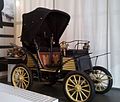Our website is made possible by displaying online advertisements to our visitors.
Please consider supporting us by disabling your ad blocker.
Portal:Cars
The Cars PortalA car, or an automobile, is a motor vehicle with wheels. Most definitions of cars state that they run primarily on roads, seat one to eight people, have four wheels, and mainly transport people rather than cargo. There are around one billion cars in use worldwide. The French inventor Nicolas-Joseph Cugnot built the first steam-powered road vehicle in 1769, while the Swiss inventor François Isaac de Rivaz designed and constructed the first internal combustion-powered automobile in 1808. The modern car—a practical, marketable automobile for everyday use—was invented in 1886, when the German inventor Carl Benz patented his Benz Patent-Motorwagen. Commercial cars became widely available during the 20th century. The 1901 Oldsmobile Curved Dash and the 1908 Ford Model T, both American cars, are widely considered the first mass-produced and mass-affordable cars, respectively. Cars were rapidly adopted in the US, where they replaced horse-drawn carriages. In Europe and other parts of the world, demand for automobiles did not increase until after World War II. In the 21st century, car usage is still increasing rapidly, especially in China, India, and other newly industrialised countries. Cars have controls for driving, parking, passenger comfort, and a variety of lamps. Over the decades, additional features and controls have been added to vehicles, making them progressively more complex. These include rear-reversing cameras, air conditioning, navigation systems, and in-car entertainment. Most cars in use in the early 2020s are propelled by an internal combustion engine, fueled by the combustion of fossil fuels. Electric cars, which were invented early in the history of the car, became commercially available in the 2000s and are predicted to cost less to buy than petrol-driven cars before 2025. The transition from fossil fuel-powered cars to electric cars features prominently in most climate change mitigation scenarios, such as Project Drawdown's 100 actionable solutions for climate change. (Full article...) Entries here consist of Good and Featured articles, which meet a core set of high editorial standards.
The Lotus T128 is a Le Mans Prototype 2 (LMP2) designed by former Sauber technical director James Key and built by Advanced Design and Engineering Systems Solutions (ADESS) and Kodewa. It was used by Kodewa in the 2013 FIA World Endurance Championship under the name Lotus. Stéphane Chosse, the founder of ADESS, first proposed building a Le Mans prototype car in March 2011. The vehicle's construction began in February 2013, eleven months after Kodewa acquired two chassis. The T128's aerodynamic study was carried out using a computer-aided software mesh tool from Altair Engineering, and aerodynamics was the main priority in its design, with Chosse taking a similar approach as when he was involved in Formula One. It uses a naturally aspirated V8 engine from the BMW S65, which is also used in the company's M3 model, and produces around 450 horsepower (340 kW). The programme was officially announced during the 2012 24 Hours of Le Mans race weekend, and its scheduled first test in December was delayed by seven weeks to allow for the installation of additional parts. Both cars failed to finish the season-opening 2013 6 Hours of Silverstone but finished in the top six at Spa-Francorchamps. A legal dispute over unpaid invoices arose during the 24 Hours of Le Mans, resulting in the cars being temporarily seized by bailiffs until a Le Mans court ordered their return after Lotus proved that the invoices were fictitious. Both cars failed to finish the race and the subsequent round in São Paulo. Lotus took their only podium of the season at the 6 Hours of Circuit of the Americas, but finished no higher than sixth in the final three races. The two T128s finished seventh and eighth in the FIA Endurance Trophy for LMP2 Teams. After the season, Lotus moved into LMP1 and replaced the T128s with a new car, the CLM P1/01. (Full article...) Selected article - Bizzarrini S.p.A. was an Italian automotive manufacturer. In 1964, the company was founded by former Alfa Romeo, Ferrari and Iso engineer Giotto Bizzarrini. The company built a small number of highly developed and advanced sports and racing automobiles before failing in 1969. In 2020, it was announced that the name had been acquired by Pegasus brands, together with plans to restart production. Originally Prototipi Bizzarrini s.r.l., the name was changed to Bizzarrini S.p.A. in 1966. Notable models include the 5300 GT Strada, 5300 GT Spyder S.I., and the P538S. Attempts to bring back the Bizzarrini name resulted in a number of concept cars in the 2000s. (Full article...) Selected picture of the day
Selected biography -Soichiro Honda (本田 宗一郎, Honda Sōichirō, 17 November 1906 – 5 August 1991) was a Japanese engineer and industrialist. In 1948, he established Honda Motor Co., Ltd. and oversaw its expansion from a wooden shack manufacturing bicycle motors to a multinational automobile and motorcycle manufacturer. (Full article...) On this day February 7
Did you know...
Selected quote of the dayThe Aston Martin DB9 is the car that I'd be most likely to sell my children into slavery for. TopicsGeneral imagesThe following are images from various car-related articles on Wikipedia.
CategoriesThings you can do to help If you wish to help, you can:
Associated WikimediaThe following Wikimedia Foundation sister projects provide more on this subject:
Discover Wikipedia using portals |
Previous Page Next Page












































































